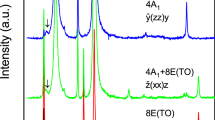Abstract
A procedure is described which allows optimisation of the positional parameters of like ions (cations or anions, respectively) under the influence of repulsive Coulomb forces. The structure is regarded as being composed of subsets for which the Coulomb energy is particularly low. Each assignment of ions to subsets allows derivation of a model with individual symmetry and parameters. Because the structure is only partly ionic and other forces than Coulomb repulsion are ignored, the positional parameters are different from the actual values of the structure. Despite the simplified treatment, there are discussions of the relative lengths of SiO bonds, the cation ordering in the quartz-like structure AlPO4, the pressure dependence of α-quartz and the symmetry of the quartz variants. For oxygen in quartz, 3 models are obtained with the symmetry of α-quartz and one with the symmetry of β-quartz. For Si, only one model is obtained which has more similarity with α- than with β-quartz. The α-β transformation is attributed to the various kinds of optimisation of Coulomb energy of oxygen.
Similar content being viewed by others
References
Bärlocher C, Hepp A, Meier WM (1977) DLS-76. A program for the simulation of crystal structures by geometric refinement. Institute of Crystallography and Petrography, ETH, CH-8092 Zürich, Switzerland
Bärnighausen H (1980) Group-subgroup relations between space groups: a useful tool in crystal chemistry. Comm MATCH in math chem 9:139–175
Brunner GO (1971) An unconventional view of the ‘closest sphere packings’. Acta Crystallogr A 27:388–390
Brunner GO (1975) Simulation von zweidimensionalen Kristall-strukturen, von Störstellen und von Gitterschwingungen mit schwebenden Magneten. Z Kristallogr 142:281–292
Brunner GO (1977) A definition of coordination and its relevance in the structure types AlB2 and NiAs. Acta Crystallogr A 33:226–227
Chabot B, Cenzual K, Parthé E (1981) Nested polyhedra units: a geometrical concept for describing complicated cubic structures. Acta Crystallogr A 37:6–11
Chung SJ, Hahn Th (1975) Possible and existing tetrahedral frameworks. Abstract in Acta Crystallogr Suppl A 31:1
D'Amour H, Denner W, Schulz H (1979) Structure determination of α-quartz up to 68 × 108 Pa. Acta Crystallogr B 35:550–555
Fedorow E von (1904) Allgemeinste Krystallisationsgesetze und die darauf fußende eindeutige Aufstellung der Kristalle. Z Kristallogr Mineral 38:321–490
Fedorow E von (1920) Das Kristallreich. Tabellen zur kristallochemischen Analyse. Petrograd
Gramlich-Meier R, Meier WM (1982) Constituent units and framework conformations in zeolite networks. J Solid State Chem 44:41–49
Gramlich-Meier R, Gramlich V (1982) The zeolite A debate: how wrong is a nearly correct space group? Acta Crystallogr A 38:821–825
Guigas B, Klee WE (1976) On the generation of plane nets. Z Kristallogr 144:304–313
Hansen S, Andersson S, Fälth L (1982) A description of the feld-spar framework. Z Kristallogr 160:9–17
Hellner E, Koch E (1981) Cluster or framework considerations for the structures of Tl7Sb2, α-Mn, Cu5Zn8 and their variants Li22Si51, Cu41Sn11, Sm11Cd45, Mg6Pd and Na6Tl with octuple unit cells. Acta Crystallogr A 37:1–6
Le Page Y, Donnay G (1976) Refinement of the crystal structure of low-quartz. Acta Crystallogr B 32:2456–2459
Levien L, Prewitt CT, Weidner DJ (1980) Structure and elastic properties of quartz at pressure. Amer Mineral 65:920–930
Liebau F, Böhm H (1982) On the coexistence of structurally different regions in the low-high quartz and other displacive phase transformations. Acta Crystallogr A 38:252–256
Neubüser J, Wondratschek H (1966) Untergruppen der Raumgruppen. Krist Tech 1:529–543
Ngo Thong, Schwarzenbach D (1979) The use of electric field gradient calculations in charge density refinements. II Charge density refinement of the low quartz structure of aluminum phosphate. Acta Crystallogr A 35:658–664
Niggli P (1926) Lehrbuch der Mineralogie II Spezielle Mineralogie, pp 662–663. 2nd ed Berlin
Nyman H, Hyde BG (1981) The related structures of α-Mn, sodalite, Sb2Tl7 etc. Acta Crystallogr A 37:11–17
O'Keeffe M (1981) Some aspects of the ionic model of crystals. In: O'Keeffe M, Navrotsky A (ed) Structure and Bonding in Crystals I. Academic Press Inc, London, pp 299–322
Schwarzenbach D (1966) Verfeinerung der Struktur der Tiefquarzmodifikation von AlPO4. Z Kristallogr 123:161–185
Smith JV, Bennet JM (1981) Enumeration of 4-connected 3-dimensional nets and classification of framework silicates: the infinite set of ABC-6 nets; the Archimedean and σ-related nets. Amer Mineral 66:777–788
Smith GS, Isaacs PB (1964) The crystal structure of quartzlike GeO2. Acta Crystallogr 17:842–846
Stewart RF, Spackman MA (1981) Charge density distributions. In: O'Keeffe M, Navrotsky A (ed) Structure and Bonding in Crystals I. Academic Press Inc, London, pp 279–298
Villars P, Girgis K, Niggli A (1983) Coordination polyhedra and structures of alloys: binary alloys of niobium (and tantalum) with group III b and IV b elements. Acta Crystallogr B 39:603–606
Author information
Authors and Affiliations
Rights and permissions
About this article
Cite this article
Brunner, G.O. An interpretation of the structures of α- and β-quartz based on coulomb repulsion forces. Phys Chem Minerals 10, 273–279 (1984). https://doi.org/10.1007/BF00311952
Received:
Issue Date:
DOI: https://doi.org/10.1007/BF00311952




